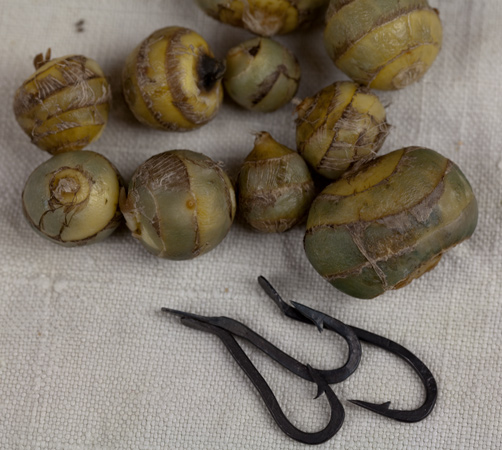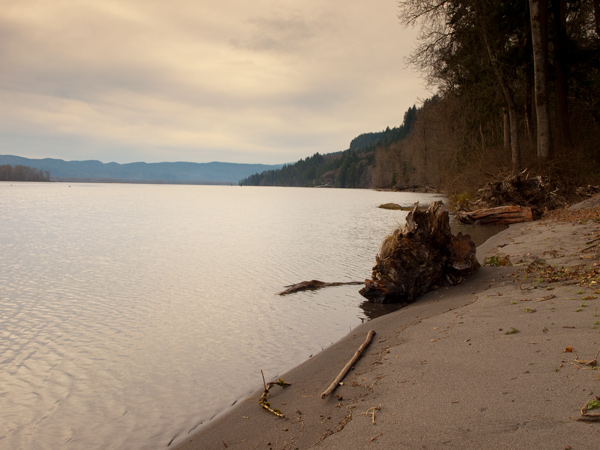After a rainy night, the men paddle down the Columbia in the rain. From various villages near the mouth of the Cowlitz River, they buy salmon and wapato and are told that Captain Haley visits the mouth of the Columbia. At their camp at Little Cape Horn, they build large fires to dry out and kill the fleas infesting their blankets.
In Washington City, President Jefferson writes to William Hamilton regarding seeds of Native tobacco and echinacea that were sent with the barge from Fort Mandan.
Wapato and Fish Hooks
© 2012 by Kristopher K. Townsend. Permission to use granted under the Creative Commons Attribution-Share Alike 4.0 International license.
Wet Morning
Several Showers of rain in the course of last night. the guard had to attend to the canoes to keep them loose as the tide Ebbs & flows abt. 3 feet pertular. a cloudy wet morning. we Set out eairly and proceeded on.
—Joseph Whitehouse
Buying Food
Some Indians came out in the River to us with their canoes. we bought Some fresh fish from them, and bought Some fine roots from a canoe which was going down the R. with a load trading
—Joseph Whitehouse
Mount Coffin
I had like to have forgotten a verry remarkable Knob riseing from the edge of the water to about 80 feet high, and about 200 paces around at its Base
—William Clark
News of Trading Ships
we over took two Canoes of Indians going down to trade one of the Indians Spoke a fiew words of english and Said that the principal man who traded with them was Mr. Haley, and that he had a woman in his Canoe who Mr. Haley was fond of &c. he Showed us a Bow of Iron and Several other things which he Said Mr. Haley gave him.
—William Clark
Little Cape Horn, Columbia River
© 19 December 2010 by Kristopher K. Townsend. Permission to use granted under the Creative Commons Attribution-Share Alike 4.0 International license.
Drying Out at Little Cape Horn
no place for several Miles suffcently large and leavil for our camp we at length Landed at a place which by moveing the Stones we made a place Sufficently large for the party to lie leavil on the Smaller Stones Clear of the Tide Cloudy with rain all day we are all wet and disagreeable, had large fires made on the Stone and dried our bedding and Kill the flees [fleas]
—William Clark
Weather Diary
Day of the month Wind State of the Weather 6th S W. rain after rain rained the greater part of the day moderately.
—Meriwether Lewis[2]Some abbreviations have been spelled out.
Lewis’s Seed Packets
Washington Nov. 6. 05
Dear Sir
I happen to have two papers of seeds which Capt Lewis inclosed to me in a letter, and which I gladly consign over to you, as I shall any thing else which may fall into my hands & be worthy your acceptance. one of these is of the Mandan tobacco, a very singular species uncommonly weak & probably suitable for segars. the other had no ticket but I believe it is a plant used by the Indians with extraordinary success for Curing the bite of the rattle snake & other venomous animals.
Th: Jefferson[3]Letters of the Lewis and Clark Expedition with Related Documents: 1783-1854, 2nd ed., ed. Donald Jackson (Urbana: University of Illinois Press, 1978), 269–70.
Notes
| ↑1 | Yvonne Hadja, Handbook of North American Indians: Northwest Coast Vol. 7, ed. Wayne Suttles (Washington, D.C.: Smithsonian Institution, 1990), 516. |
|---|---|
| ↑2 | Some abbreviations have been spelled out. |
| ↑3 | Letters of the Lewis and Clark Expedition with Related Documents: 1783-1854, 2nd ed., ed. Donald Jackson (Urbana: University of Illinois Press, 1978), 269–70. |
Experience the Lewis and Clark Trail
The Lewis and Clark Trail Experience—our sister site at lewisandclark.travel—connects the world to people and places on the Lewis and Clark Trail.
Discover More
- The Lewis and Clark Expedition: Day by Day by Gary E. Moulton (University of Nebraska Press, 2018). The story in prose, 14 May 1804–23 September 1806.
- The Lewis and Clark Journals: An American Epic of Discovery (abridged) by Gary E. Moulton (University of Nebraska Press, 2003). Selected journal excerpts, 14 May 1804–23 September 1806.
- The Lewis and Clark Journals. by Gary E. Moulton (University of Nebraska Press, 1983–2001). The complete story in 13 volumes.



